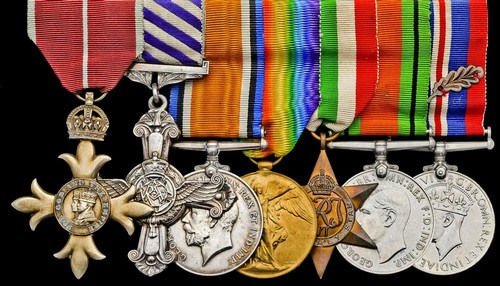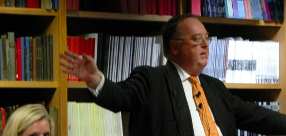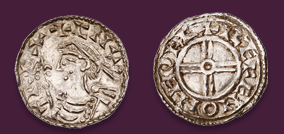
Auction: 14001 - Orders, Decorations, Campaign Medals and Militaria
Lot: 70
A Scarce and Extremely Well Documented 1945 'Military Division' O.B.E., Great War 'Mediterranean Theatre' D.F.C. Group of Seven to D.H.4 and D.H.9 Observer, Lieutenant, Later Wing Commander L.A. Jessop, Royal Naval Air Service and Royal Air Force, Who Carried Out a Series of Long Range Bombing Raids on Constantinople, Including The First Night Raid On the City, 19.8.1918
a) The Most Excellent Order of the British Empire, 2nd type, Military Division, Officer's (O.B.E.) breast Badge
b) Distinguished Flying Cross, G.V.R., upper arm of reverse engraved 'L.A. Jessop'
c) British War and Victory Medals (Lieut. L.A. Jessop. R.A.F.)
d) Italy Star
e) Defence Medal
f) War Medal, M.I.D. Oak Leaf, generally very fine, mounted as originally worn, with the following contemporary related items:
- Observer's Brevet
- Two Royal Naval Air Service Pilot's Flying Log Books (12.3.1917-26.9.1917 and 22.10.1917-18.11.1918), both well annotated; and R.A.F. Pilot's Flying Log Book (August 1936-December 1949)
- Bestowal Document for the Order of the British Empire, dated 1.1.1945, with named enclosure for document and award
- Three M.I.D. Certificates, dated 24.9.1941, 1.1.1942 and 11.6.1942
- Commission appointing Laurence Arthur Jessop an Observer Sub-Lieutenant in the Royal Naval Air Service, dated 22.10.1917
- Commission appointing recipient a Lieutenant in the Royal Air Force, dated 1.11.1918
- Commission appointing recipient a Flying Officer in the Reserve of Air Force Officers, dated 23.11.1938
- Commission appointing recipient a Flight Lieutenant in the Royal Air Force Volunteer Reserve, dated 16.12.1939
- Two Portrait photographs of recipient in uniform, a number of photocopied images from various stages of his career and several newspaper cuttings
- Copy of recipient's typed account of services during the Great War (lot)
O.B.E. London Gazette 1.1.1945 Wing Commander Laurence Arthur Jessop (76181), Royal Air Force Volunteer Reserve
D.F.C. London Gazette 3.12.1918 Lieut. Laurence Arthur Jessop. (Sea Patrol, Mediterranean)
'An officer of fine courage and resolution. He has rendered most valuable service in bombing an important enemy town on a long-distance raid, bringing back a valuable reconnaissance report.'
Wing Commander Laurence Arthur Jessop, O.B.E., D.F.C., born 1898, the son of Major G.W. Jessop, J.P., of Cliffe Cottage, Rawdon, Leeds; educated at Uppingham and Oriel College, Oxford; in the 'autumn of 1916 I applied to the Admiralty to join the Royal Naval Air Service, and just after my eighteenth birthday on November 8th was commanded to attend for interview and medical examination... I had the usual searching kind of interview when you were asked all kinds of questions, some of which seemed at first to have little relevance, such as "could you referee a hockey match". The medical examination was very thorough, and at one stage you had to climb a rope, and at another while the examiner held a very sensitive portion of your anatomy you were told to "cough". It was generally believed that one applicant thought the examiner said "Jump" with painful results.' (Personal Account refers); Jessop was appointed Probationary Flight Officer (Temp.) Royal Naval Air Service, 31.12.1916, and told to report to Crystal Palace for training; in March 1917 'I was posted to the Naval Air Station at Redcar in North Yorkshire, to learn to fly. We were divided into squads for lectures and flying instruction... I had my first flight on March 12th, found it very interesting and exciting, but rather baffling. The aircraft was a Caudron, with a rotary engine and blip switch, not an easy aircraft to start on. My instructor's idea was to hit you on the head and shout at you if you did anything wrong. Each flight averaged about 12 minutes, in some cases only 4 or 5 minutes, and it was difficult in such short periods to get the feel of the aircraft'; after a period of illness he returned to carry out the rest of his training in a Maurice Farman, 'sad to relate on my second solo on May 7th I crashed the aircraft and wrote it off completely, after a stall. Just previously I had taxied another Maurice Farman into the saluting base and flag staff. Not at all a popular move... It was suggested to me quite kindly that I wouldn't make a pilot and would I like to become a Kite balloon pilot or a Naval Observer.'
Jessop was posted as Probationary Observer Officer, to R.N.A.S. Eastchurch, 31.5.1917; he carried out further training and was promoted Observer Sub-Lieutenant, 5.10.1917; posted to No.2 Aeroplane Wing, R.N.A.S., British Aegean Squadron, Mudros, Lemnos, November 1917; on the '24th November I was posted to "B" Squadron, Kalloni on the island of Mitylene, or to give its ancient name of Lesbos... I joined up with my first operational pilot, Flight Sub-Lieutenant Evans at Mitylene, and we stayed together from our first flight on December 11th 1917 until June 8th 1918... The aircraft were two seater Sopwith Fighters, and single seater Camels... On our first flight we patrolled the Turkish coast to spot a battery of howitzers which had been firing on Mitylene. We went up to 11,000 feet over Smyrna... A laconic note in my log book "very cold (Nose froze)", painful... We carried out Dawn Patrols off the Turkish coast with Mount Ida in the distance. Went up on a number of occasions to intercept enemy aircraft, took numerous photographs'; on 20.1.1918, 'Patrol to reconnoitre as S.M.S. Goeben and Breslau were outside the Dardanelles. Carried W.T. and Aldis Lamp' (Log Book refers); he carried out numerous photo-reconnaissance and escort missions, 'we escorted on various occasions Green Naval vessels. Before operating your W/T you had to unwind a long steel cable with a lead weight on the end, as a trailing aerial, if you forgot to wind in before landing your trailing aerial could cause some havoc. The aerial got stuck on one sortie and I had to climb onto the wing to release it. Sounds very dangerous, but it wasn't, as aircraft flew so slowly that there wasn't much slipstream. In Mudros harbour later I thumbed a lift in a Short Seaplane, and rather to the annoyance of the pilot I sat out on the fuselage and wrote a letter home to Mother while in flight' (Personal Account refers).
'B' Squadron was disbanded in April 1918, with Jessop's flight leaving Mitylene for Mudros, and forming 'F' Squadron; the latter was equipped with D.H.4's and was 'a mobile squadron... this squadron operated from a number of island airfields, Lemnos, Mitylene, Thasos, Imbros and Marian and Stavros on the mainland near Salonica. From Imbros we bombed Gallipoli and from Thasos the airfields and seaplane station at Drama and Gereviz... From Marian on the Serbian border we bombed dumps at Marinopol and Livuno...
On June 5th 1918 Evans and I set out to bomb Kuleli-Burgas when forty miles inside Bulgarian territory the oil tank began to leak very heavily so we turned back for home, crossing over enemy territory at about 1,000 feet, at Enos. The aircraft lost power gradually, and eventually with a large puff of smoke and flame gave up altogether, so we had to land in the sea in the Gulf of Saros, some miles from Imbros. There was a debate in the Mess the day before as to whether a D.H.4 would sink at once, and we proved it wouldn't. The only casualty to ourselves apart from the shock on landing, was my pair of shoes which I took off expecting to have to swim. They sank and until I got a new pair of shoes I had to appear in slippers... We were rescued by the Royal Naval M.L. 186, and eventually landed at Mudros.'
In July 1918 Jessop went with 'A' Flight to Marsh Aerodrome, near Mudros; they were equipped with D.H.9's and 'I was now observer to the Flight Commander, Captain "Bud" Wiser, a Canadian. One of my duties was to look after his dog Zum, a Sealyham, who always went with me in the cockpit on our travels... In June and July 1918 plans were made to bomb Constantinople.. The aircraft had to have a number of extensive modifications to carry more petrol and to fit extra radiator capacity. On 6th July 1918 we landed on the airfield on Imbros, the nearest airfield to the target... The formation of five D.H.9's took off at 7.10am, landing at Imbros at 11.55, a flight of four hours and forty five minutes. I dropped my bombs from 4,000 feet, on Haidar-Pasha and the Oriental Railway stations, also on the powder works at Makrikeui, scoring direct hits... Three enemy aircraft attacked the formation, our aircraft had a number of bullet holes through the bottom wing... The aircraft were operating at the extreme limit of their range, and at the end of the flight had to locate a small aerodrome on a little island... On 23rd July we repeated the raid on Constantinople with six D.H.9's. I dropped bombs on the docks, Taxim Pera barracks and San Stefano aerodrome. There was a festival in the town which we disturbed somewhat'; on the 19th August Jessop took part in the first night attack on Constantinople; he followed this up on the 27th August, where he was met with heavy anti-aircraft fire, and a crash landing on his return to base; at the end of September the flight was attached to 17 Squadron, Royal Flying Corps; based in Amboukoi, north of Salonica, they were tasked with harrassing the Bulgarian retreat through Serbia; throughout this month Jessop and his pilot carried out a number of low-level attacks on retreating troops and transport; with the surrender of Bulgaria the flight returned to Marsh Aerodrome, October 1918; he continued to fly reconaissance until peace was declared with Turkey at the end of the month, 'I sailed from Mudros on 12th December... docked at Southampton on New Year's Day 1919... Later in January I reported at the Air Ministry in the Cecil Hotel, where I was greeted with some surprise as I had been posted to Russia. Luckily for me the posting had never reached the Headquarters in Mudros and it was eventually, after some argument, agreed that I could be demobilised'; Jessop transferred into the Reserve of Officers, and was employed with Transport Command, from 1936; he was appointed Adjutant of Advanced Training Squadron at No.3 Flying Training School; Flying Officer, Royal Air Force Reserve, 24.4.1938; he transferred to Coastal Command and was posted to R.A.F. Station Pembroke Dock, April 1939; Flight Lieutenant, 1.9.1939; served at Coastal Command HQ, Northwood,1942-45, flying in a large number of different aircraft; subsequent post-war appointments included with the Air Division in Austria, and with Fighter Command; after the war Jessop contributed to Task For Coastal Command by Hector Bolitho.
Subject to 20% VAT on Buyer’s Premium. For more information please view Terms and Conditions for Buyers.
Sold for
£3,500




